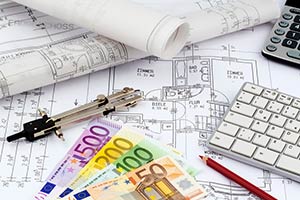Current
informs.
All news at a glance.

We keep you up to date
We bring you the latest developments and news directly to your screen!
Current dates and developments always in view.
VAT apportionment standard for mixed-use properties
The tax authorities have explained when which apportionment standard is to be applied for the input tax deduction from expenses for mixed-use properties.
Only a proportionate input tax deduction is possible from supplies and services that are not used in full to generate sales subject to VAT. Taxpayers and tax authorities often argue about the correct allocation of costs, particularly in the case of construction and repair costs for mixed-use buildings or subsequent installations in mixed-use buildings. The Federal Ministry of Finance has therefore summarized the legal situation and the current state of case law and adapted the VAT application decree to the case law.
For building owners, the turnover key, which has priority under EU law, may be more favorable for input tax apportionment, particularly if higher rents can be achieved in the commercial part of the property. In German VAT law, however, a turnover key is only permissible if no other allocation method is available. As a rule, the area key is therefore used, and in 2012 the European Court of Justice also confirmed that member states are free to prescribe an allocation key other than the turnover key as a priority. According to the ruling, the only requirement is that the chosen method ensures a more precise determination of the correct input tax share.
The Federal Fiscal Court followed this and determined in 2014 that an input tax allocation based on the turnover key is only permissible if no more precise economic allocation is possible. As a rule, the area key excludes the turnover key as a more precise allocation. However, the input tax amounts cannot be apportioned according to the area key if there are significant differences in the furnishings of the premises.

If the area key does not represent a more precise economic allocation, the method that enables a more precise allocation applies instead: If the input VAT amounts relate to the turnover generated with the building itself (rental turnover), an object-related turnover key is more accurate. If, on the other hand, the building is used for the turnover of the entire company (e.g. an administration building), a turnover key based on total turnover is justified, according to the Federal Fiscal Court.
In further rulings, the European Court of Justice and subsequently the Federal Fiscal Court also decided in 2016 that, in contrast to input supplies for the use, maintenance and upkeep of a mixed-use building, input VAT deduction cannot be based on which expenses are incurred in specific parts of the building. Instead, it depends on the percentage use of the entire building. In contrast, maintenance measures could simply be allocated directly to the various usage shares.
Due to these and several other rulings, the Federal Ministry of Finance has carried out the long overdue revision of the relevant administrative instruction and incorporated the changes into the VAT application decree. As a result, the following rules now apply to the apportionment of input tax for mixed-use buildings:
-
Input services: In the case of services for the use and maintenance of mixed-use buildings, the costs must initially be allocated directly to the output transactions as far as possible. Any remaining input VAT amounts must then be allocated appropriately using the following guidelines. If, on the other hand, a mixed-use building is acquired or constructed, the total input VAT amounts attributable to the acquisition or construction costs of the building must be divided uniformly into a deductible and a non-deductible part. There is then expressly no prior direct allocation of input services to output transactions.
-
Selection of methods: Input tax must be apportioned according to an appropriate apportionment key, i.e. according to a key that is suitable as an apportionment standard for the building. If other apportionment keys besides the total turnover key come into question, another key must be used if it provides a more precise result. If several other allocation keys are possible, the most precise method does not necessarily have to be used. In such cases, the choice of method is made by the entrepreneur. However, the tax office can check whether it is appropriate. In particular, a property-related area key, a property-related turnover key or a key based on the converted space can be considered.
-
Area key: In principle, input tax is apportioned in proportion to the usable floor space of the building (property-related floor space key), as the tax authorities are convinced that this is generally the more precise method of apportionment, but only if it is also appropriate.
-
Turnover key: An object-related turnover key can only be considered if the equipment of the differently used rooms differs significantly (see below). Only in exceptional cases can a total turnover key be used in such cases, e.g. for administrative buildings that serve the turnover of the entire company.
-
Converted space: If there are significant differences in the storey height, input VAT may be apportioned according to the converted space instead of the total turnover key if this apportionment enables a more precise economic allocation of the input VAT amounts. This can be assumed if the parts of the building have different storey heights but otherwise no significant differences in the fittings.
-
Other keys: In individual cases, other allocation keys may also be appropriate. For example, in the case of a sports hall, the Federal Fiscal Court ruled that if the building is used alternately for tax-exempt and taxable purposes, a division according to the periods of use is most suitable. A division based on the area key is not an option if it is not a question of the constant use of different parts of the building, but of the alternating use of the same parts over time.
-
Area calculation: In principle, the floor areas of all rooms are to be used for the area calculation, regardless of whether they are residential or commercial areas (residential and sales rooms, cellars or storage rooms used as warehouses, underground parking). However, only the interior areas of the building count, i.e. not, for example, outdoor parking spaces. Areas that are used to supply the building or are only used jointly (e.g. utility rooms, stairwells, bicycle storage rooms, laundry rooms) are not taken into account. Likewise, rooms not intended for conversion from the outset are not to be included in the area calculation. The floor areas are also to be included in full in the case of sloping roofs. The areas of terraces or balconies count as half. An alternative recognized method for calculating floor space can be used for the purposes of input tax apportionment if the chosen method is also used for other purposes (e.g. rental agreements), the floor space is calculated uniformly for the entire building and the result is appropriate.

-
Burden of proof: The burden of establishing that the area key is more precise than a turnover key lies with the tax office. However, this only applies if the tax office has all the information required for a corresponding assessment. If not all the necessary information is available or does not allow a clear assessment to be made, it can be assumed that the area key generally provides the more precise results.
-
Differences in equipment: Significant differences in the fittings can always be assumed if the thickness of the ceilings and walls or the interior fittings differ significantly from one another. The tax authorities then assume that the amount of construction work required for the various rooms also differs considerably and that the actual rental income that can be generated differs significantly. However, differences based solely on the different uses, which have similar construction costs, do not in themselves constitute a significant difference in equipment. This applies, for example, to a different number and type of electricity and water connections for private and commercial tenants or the installation of ceiling-high all-glass door elements only in the commercially used part of the building and normal windows in the residential area. Differences are only significant if they also lead to significantly different construction costs for just one part of the building. This is particularly the case if one room is luxurious while the other is simply fitted out, or if more complex construction costs are incurred for only one part of the building, e.g. load-bearing glass-reinforced floors for commercial use. There are also considerable differences in equipment if the tenants use different facilities (e.g. swimming pool used only by the tenants of the residential area) or if the use of areas within the building and on its roof differs considerably.
-
photovoltaic system: A photovoltaic system used to generate income, the costs of which are included in the acquisition or production costs of the building for income tax purposes (e.g. because it was already installed during construction), is no longer an independent object of allocation for VAT purposes. However, the system only represents a significant difference in equipment for the entire building on simple buildings (sheds, stables, garages, etc.). In all other cases, input tax must be apportioned in two stages. In the first stage, a property-related turnover key must be used to determine the proportion of roof space used by the system. The input tax amounts then attributable to the rest of the building must be apportioned in the second stage according to the general principles, i.e. usually according to an area key.
-
Allocation standard: The guidelines now published also apply in a comparable way to the allocation of a mixed-use property to the company. This is particularly important for checking whether at least 10 % of the property is used for business purposes, as otherwise an input tax deduction is completely ruled out.
The new rules apply to all open cases with two exceptions. This means that even if an annual VAT return has already been submitted and accepted by the tax office, there is no protection of legitimate expectations because the VAT assessment is generally subject to review. The only exception is if the entrepreneur refers to the previous requirements when allocating photovoltaic systems, combined heat and power plants or other operating equipment or when allocating construction costs to individual sales for use in the case of significantly different equipment or room heights.